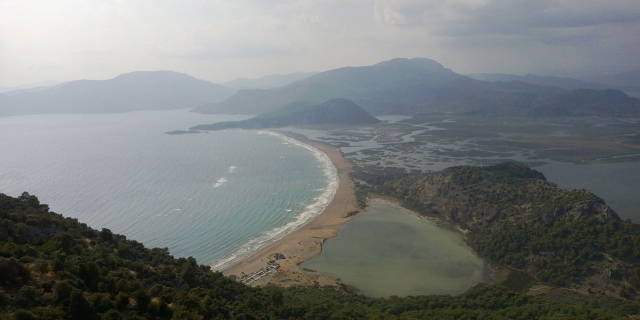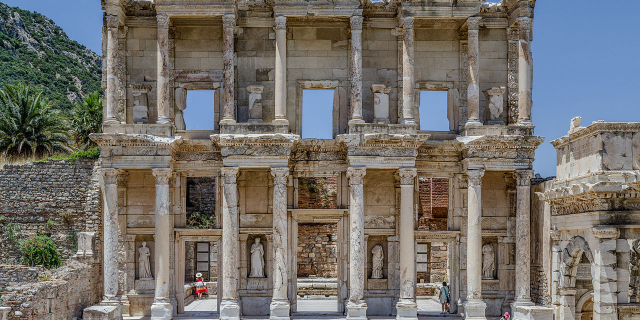Afrodisias
( Aphrodisias )
Aphrodisias (; Ancient Greek: Ἀφροδισιάς, romanized: Aphrodisiás) was a small ancient Greek Hellenistic city in the historic Caria cultural region of western Anatolia, Turkey. It is located near the modern village of Geyre, about 100 km (62 mi) east/inland from the coast of the Aegean Sea, and 230 km (140 mi) southeast of İzmir.
Aphrodisias was named after Aphrodite, the Greek goddess of love, who had here her unique cult image, the Aphrodite of Aphrodisias. According to the Suda, a Byzantine encyclopedic compilation, before the city became known as Aphrodisias (c. 3rd century BCE) it had three previous names: Lelégōn Pólis (Λελέγων πόλις, "City of the Leleges"), Megálē Pólis (Μεγάλη Πόλις, "Great City"), and Ninóē (Νινόη).
Some...Read more
Aphrodisias (; Ancient Greek: Ἀφροδισιάς, romanized: Aphrodisiás) was a small ancient Greek Hellenistic city in the historic Caria cultural region of western Anatolia, Turkey. It is located near the modern village of Geyre, about 100 km (62 mi) east/inland from the coast of the Aegean Sea, and 230 km (140 mi) southeast of İzmir.
Aphrodisias was named after Aphrodite, the Greek goddess of love, who had here her unique cult image, the Aphrodite of Aphrodisias. According to the Suda, a Byzantine encyclopedic compilation, before the city became known as Aphrodisias (c. 3rd century BCE) it had three previous names: Lelégōn Pólis (Λελέγων πόλις, "City of the Leleges"), Megálē Pólis (Μεγάλη Πόλις, "Great City"), and Ninóē (Νινόη).
Sometime before 640, in the Late Antique period when it was within the Byzantine Empire, the city was renamed Stauropolis (Σταυρούπολις, "City of the Cross").
In 2017, it was inscribed on the UNESCO World Heritage Site list.
Aphrodisias was the metropolis (provincial capital) of the region and Roman province of Caria.[1]
White and blue-grey Carian marble was extensively quarried from adjacent slopes in the Hellenistic and Roman periods, for building facades and sculptures. Marble sculptures and sculptors from Aphrodisias became famous in the Roman world. Many examples of statuary have been unearthed in Aphrodisias, and some representations of the Aphrodite of Aphrodisias also survive from other parts of the Roman world, as far afield as Pax Julia in Lusitania.[2]
The city had notable schools for sculpture, as well as philosophy, remaining a centre of paganism until the end of the 5th century.[1] It was destroyed by earthquake in the early 7th century, and never recovered its former prosperity, being reduced to a small fortified settlement on the site of the ancient theatre.[1] Around the same time, it was also renamed to Stauropolis (Greek: Σταυροῡπολις, "city of the Cross") to remove pagan connotations, but already by the 8th century it was known as Caria after the region, which later gave rise to its modern Turkish name, Geyre.[1][3] In Byzantine times, the city was the seat of a fiscal administrative unit (dioikesis).[3]
Aphrodisias was sacked again by the rebel Theodore Mankaphas in 1188, and then by the Seljuk Turks in 1197. It finally fell under Turkish control towards the end of the 13th century.[1]
Geological historyThe site is in an earthquake zone and has suffered a great deal of damage at various times, especially in severe tremors of the 4th and 7th centuries. An added complication was that one of the 4th century earthquakes altered the water table, making parts of the town prone to flooding. Evidence can be seen of emergency plumbing installed to combat this problem.
The city of Aphrodisias never fully recovered from the 7th century earthquake, and fell into disrepair. Part of the town was covered by the modern village of Geyre; some of the cottages were removed in the 20th century to reveal the older city. A new Geyre has been built a short distance away.
Ecclesiastical historyLe Quien (Oriens christianus, I, 899–904) mentions twenty bishops of this see. In the 7th century Stauropolis had twenty-eight suffragan bishops and twenty-six at the beginning of the 10th century.
Stauropolis is also a Roman Catholic titular metropolitan see, under the name Stauropoli (Latin: Archidioecesis Stauropolitana).[4]




























Add new comment